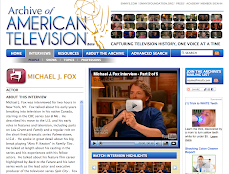
The Archive celebrates the centennial of Fran Allison (1907-89), born on November 20. Fran Allison was the host of the classic television series Kukla, Fran, and Ollie (in photo with puppeteer Burr Tillstrom). The series is called by the Museum of Broadcast Communications Encyclopedia of Television as, "the first children's show to be equally popular with children and adults." The series was done live and the dialogue was unscripted. The series began locally in Chicago in 1947 and went on NBC's midwest network in 1948 opening to the east coast in 1949 and the West Coast in 1951. As described in the Encyclopedia of Television, "Allison acted as 'straight man' to [the puppets], but her role was much more. A quick wit in her own right who could maintain the pace set by Tillstrom, Allison served simultaneously, according to Tillstrom, as 'big sister, favorite teacher, baby-sitter, girlfriend, and mother.'"

The Archive of American Television interviewed director Lewis Gomavitz, who spoke about about Kukla, Fran & Ollie in parts 2-5 of his interview.
Click here to access the entire nine-part interview with Lewis Gomavitz.

The Archive of American Television interviewed NBC stage manager Lynwood King, who spoke about Fran Allison ("Fran had a very quick wit, very fast thinking") and Kukla, Fran, and Ollie ten minutes into Part 2 of his interview.
Click here to access Lynwood King's entire six-part interview.
Lewis Gomavitz Interview Description:
Lewis Gomavitz described his involvement in the Chicago experimental station, W6XBK during World War II. After the war, he was hired on to the station, renamed WBKB, and served as a stage manager until he was tapped to direct a new show starring Burr Tillstrom's puppets and Fran Allison. The show, originally called Junior Jamboree, evolved into the classic, Kukla, Fran and Ollie. Gomavitz directed the show for ten years, until it went off the air. After that, he moved to Los Angeles where he directed and associate-produced various specials. In the 1970s, he worked as the prop master on Sanford and Son until the show went off the air. Mr. Gomavitz retired in the late 1980s. The interview was conducted by Karen Herman on February 2, 2000.
Lynwood King Interview Description:
Lynwood King talked about breaking into television in 1949 at Chicago’s WNBQ. He described the famous “Chicago School” of broadcasting pioneered by such legends as Dave Garroway and Studs Terkel. King talked about his work as a stage manager on such network series (originating from Chicago) as Studs’ Place; Garroway at Large; Zoo Parade; and Kukla, Fran, and Ollie. He recalled working as a director on such series as Hawkins Falls and, in New York, Tonight! America After Dark: the late night series that ran in between the Steve Allen and Jack Paar Tonight shows. King also talked about his work in public broadcasting and on such documentary series as Project 20. King spoke in great detail about his work as a director on the Today show, which reunited him with Dave Garroway. King also discussed his later freelance work on The Tonight Show with Johnny Carson and on soap operas, including Ryan’s Hope and One Life to Live. The interview was conducted by Jeff Kisseloff on November 20, 2002.
What are your memories of Kukla, Fran, and Ollie?
 Bandstand fans: check out this new 5-minute video produced by our partner TV Land Online featuring excerpts from the Archive's Dick Clark interview (conducted in 1999). In the photo-filled piece, he discusses his journey from radio to hosting American Bandstand -- the show's groundbreaking racial integration, the move from Philadelphia to Los Angeles, and the many cultural changes the program reflected throughout the decades it aired.
Bandstand fans: check out this new 5-minute video produced by our partner TV Land Online featuring excerpts from the Archive's Dick Clark interview (conducted in 1999). In the photo-filled piece, he discusses his journey from radio to hosting American Bandstand -- the show's groundbreaking racial integration, the move from Philadelphia to Los Angeles, and the many cultural changes the program reflected throughout the decades it aired.


















